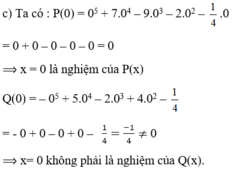
Hãy nhập câu hỏi của bạn vào đây, nếu là tài khoản VIP, bạn sẽ được ưu tiên trả lời.


1. F(-1) = 2.(-1)2 – 3. (-1) – 2 = 2.1 + 3 – 2 = 3
F(0) = 2. 02 – 3 . 0 – 2 = -2
F(1) = 2.12 – 3.1 – 2 = 2 – 3 – 2 = -3
F(2) = 2.22 – 3.2 – 2 = 8 – 6 – 2 = 0
Vì F(2) = 0 nên 0 là 1 nghiệm của đa thức F(x)
2. Vì đa thức E(x) có hệ số tự do bằng 0 nên có một nghiệm là x = 0.

\(a,x^2-2=0\Leftrightarrow x^2-\left(\sqrt{2}\right)^2=0\Leftrightarrow\left(x-\sqrt{2}\right)\left(x+\sqrt{2}\right)=0\Leftrightarrow\left[{}\begin{matrix}x=\sqrt{2}\\x=-\sqrt{2}\end{matrix}\right.\)
Vậy \(S=\left\{-\sqrt{2};\sqrt{2}\right\}\)
\(b,x\left(x-2\right)=0\Leftrightarrow\left[{}\begin{matrix}x=0\\x=2\end{matrix}\right.\)
Vậy \(S=\left\{0;2\right\}\)
\(c,x^2-2x=0\Leftrightarrow x\left(x-2\right)\) phương trình như câu b,
\(d,x\left(x^2+1\right)\Leftrightarrow\left[{}\begin{matrix}x=0\\x^2+1=0\end{matrix}\right.\Leftrightarrow\left[{}\begin{matrix}x=0\\x^2=-1\left(voli\right)\end{matrix}\right.\)( voli là vô lí )
Vậy \(S=\left\{0\right\}\)



Đặt C(x)=0
=>x2-x=0
=>x(x-1)=0
=>x=0 hoặc x=1